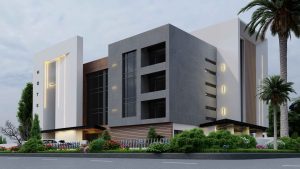A window is defined as a vented barrier secured in a wall opening. A window’s main function is to allow the entry of air and light into the building and give a view of the building’s outside. Other purposes of windows are to provide sufficient insulation against heat and cold, and in some cases, sound too.
A window is divided into two parts.
- Windowframe
- Windowshutters
In this blog post, we will briefly discuss 5 different types of windows used in buildings.
- DOUBLEHUNG WINDOWS
The double-hung window consists of a frame and pair of shutters which are arranged one above the other. Double-hung windows can only move vertically within the grooves provided in the window frame.
Both the shutters of the windows are movable so ventilation is possible from the top as well as the bottom part of the window.
It is easier to control ventilation in this type of window as it can be opened at the top and bottom to any desired extent. Cleaning the double-hung window is a lot easier. The double-hung windows are ideally seen in the patios and walkways as it remains flush with the wall.
2. SINGLEHUNG WINDOWS
Single hung windows look almost identical to double hung windows. Both have an upper and lower sash, traditional aesthetics, and are easy to operate and clean. The key difference between these styles is that both the top and bottom sashes of a double hung window are movable. Only the bottom sash operates on single hung windows.
Single hung windows are ideal for areas where the top sash might be difficult to reach. Because of their fixed top sash, single hung windows prevent more air infiltration than similar double hung windows and are more energy efficient. Additionally, single hung windows may be less expensive.
3. SLIDINGWINDOWS
Sliding windows are common these days. All modern houses are seen using sliding windows. Sliding windows are almost similar to sliding doors. The shutters of the sliding window move on small roller bearings. They can move in either a horizontal direction or a vertical direction. Suitable-sized openings are left on the walls to accommodate the shutters of the window.
Sliding windows are usually seen in homes, offices, bank counters, trains, buses, shops, etc. The major disadvantage of the sliding window is that its bearings can be damaged due to the dust particles in its frame.
4.CASEMENTWINDOW
Casement windows are the most common types of windows used. A casement window is attached to the frame using one or more hinges at the side. Casement windows are used as a single shutter window or a pair of shutters within a common window frame.
The panels of casement windows may be glazed, non-glazed, or partially glazed. In the double shuttered casement windows, the outer shutters may sometimes have wired gauged panels for fly proofing. Casement windows are a beautiful addition to any home that complement both modern and traditional home styles.
5. BAYWINDOWS
A bay window is mainly used for aesthetical purposes in a structure. These types of windows projects outside the external wall of the room. This projection may be of various shapes like triangular, circular, rectangular, and polygonal.
A bay window is also provided to get an increased area of opening which allows more amount of light to enter. Unfortunately, the formal purpose of a bay window is not to create a little space to sit in solitude and hide from relatives. It’s to increase the surface area of a wall, and therefore increase the amount of natural light that can enter through that wall. Basically, by extending the window beyond the wall, you let more light in than if you had set the window into the flat wall itself. That’s the intended function of a bay window.




